Yerba Buena (Clinopodium douglasii) is a trailing member of the Lamiaceae (mint) family, and is commonly found growing at low elevations at the edges of California’s coastal woodlands.
We had first noticed this trailing plant during a winter walk on the property, but its identity was a mystery until recently, when we finally noticed it blooming.
Yerba Buena is native to the Pacific coast, from Baja to Alaska, and also found in Idaho and Montana. It was recently renamed from Satureja douglasii to Clinopodium douglasii. Clinopodium, means “bent” or “sloping foot”. The plant’s common name, Yerba Buena, comes from the Spanish hierba buena, meaning good herb, or mint.

Yerba Buena is native to the western United States, and common at the edge of California's coastal woodlands
Its previous classification in the Satureja genus was because this aromatic herb was thought to have very similar qualities to the European culinary herbs Summer Savory (Satureja hortensis), which we grow in our gardens, and Winter Savory (Satureja montana).
Clinopodium douglasii has long been known to the native peoples of California, and used extensively as a medicinal herb, in much the same way Europeans historically used Summer and Winter Savory. Some of its uses by native Californians include a decoction leaves taken for colds and fever by the Pomo, Kashaya, Cahuilla, and Luiseno. The Karok would take an infusion of the leaves as an aphrodisiac. Infusions of the dried vines were used as a blood medicine, or as a remedy for colic, by the Mendocino Indians. [1]
Although we haven’t yet tried making Yerba Buena tea, we know of others who have, and reportedly it makes one of the best tasting wild teas. We may have to try brewing a pot of Yerba Buena tea this weekend to find out for ourselves.*
Yerba Buena is an unassuming evergreen plant, growing low to the ground, with square shaped, trailing stems. Mature plants can reach two feet in height, by six feet wide.

Yerba Buena's evergreen leaves, and trailing habit, makes it a good plant for growing over a rock wall
The leaves are heart-shaped, paired, and opposite along the length of the stem, with toothed edges.
The tiny white to pale lavender flowers appear in early summer, paired at the leaf axils, and are two lipped. The blooms however are not particularly showy unless viewed up close.
Deer and rabbits frequent the area where these plants have established themselves, but largely seem to ignore it, perhaps making this an excellent candidate for an evergreen ground cover elsewhere on the property.
Apparently our native Banana Slugs are repelled from it as well, as Clinopodium douglasii contains a number of naturally occurring chemical repellents, especially p-menthane monoterpeniods, which make the leaves unpalatable and protect the plants from grazing by slugs. [2]
Yerba Buena is growing here in a location that receives morning sun, and afternoon shade, at the base of an east facing steep slope just at the edge of a clearing. This is an area of the property that we haven’t done much to yet, but despite its wild look, a number of the plants in this area are native, including a variety of ferns, monkey flowers, hedge nettles, and in some areas an almost solid carpet of Yerba Buena.
Just up slope from where this stand of Yerba Buena is growing, Coast Redwoods and Tanbark Oaks predominate. The slope directly opposite is almost entirely Coast Live Oak, and California Bay Laurel, and completely devoid of the plant, no doubt due to the exposure of the slope to late afternoon sun.
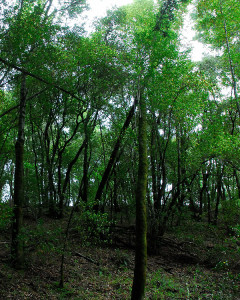
Yerba Buena grows abundantly on the opposite east facing slope, but there's none to be found on this west facing slope directly opposite
As an evergreen vining ground cover, Yerba Buena seems to be an attractive year around plant, that could be as well suited to a garden, as it is to our woodlands.
It has no difficulty tolerating our sandy soils, and reportedly also grows in clay, but is less vigorous. Propagation can be achieved both through cuttings, and from seed, and once our greenhouse construction is finished, I’m tempted to try growing some cuttings to transplant to other areas of the property that have some less desirable weeds running amok. After all, anything the deer avoid eating here is worth considering growing more of!
Less than 20 feet from where the Yerba Buena is growing uninhibited, the edge of the woodland is primarily non-native blackberry vines, and native Western Sword Ferns. Twenty feet the other way is in dense dark shade under the canopies of mature redwoods, where only Redwood Sorrel grows on the forest floor. As such, we’ll never cease to be amazed by the unique pockets of diverse vegetation growing in our woodland areas, and finding new native plants is always exciting, especially when we’re sure that there can’t be any more plants here to be discovered.
———————–
*It’s imperative before consuming the parts of any wild plant that you can accurately identify that plant. If there’s any doubt, don’t do it!
[1] Daniel E. Moerman’s Native American Ethnobotanical Database
[2] Barker, G.M. 2001. in Food and Feeding Behavior. The Biology of Terrestrial Molluscs. p. 270

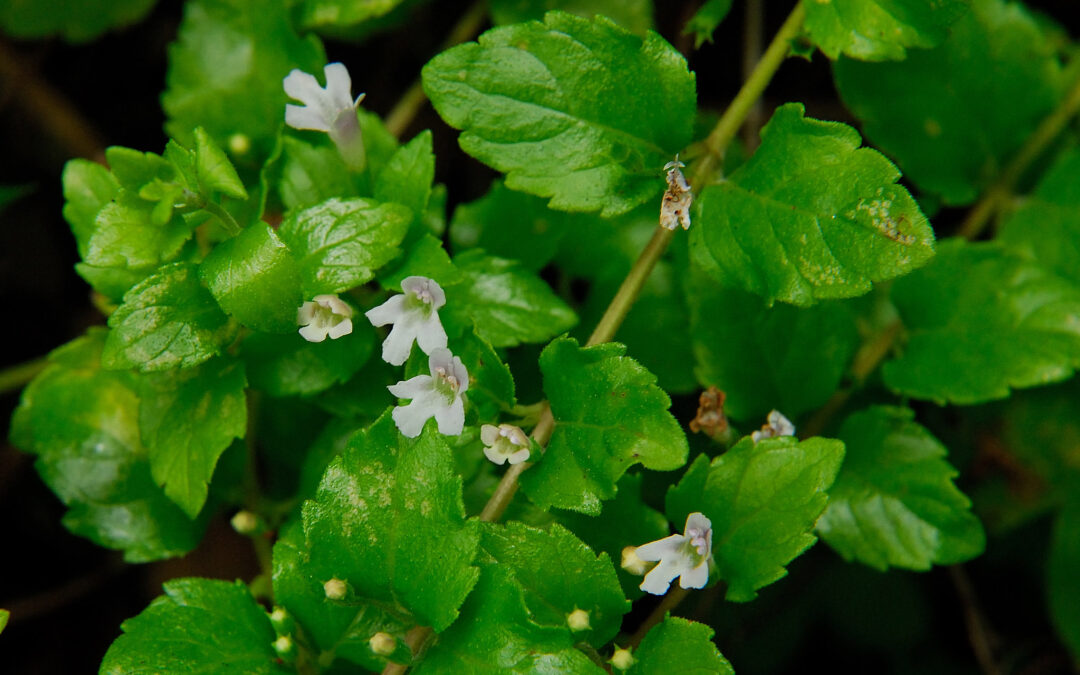

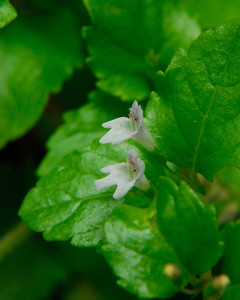
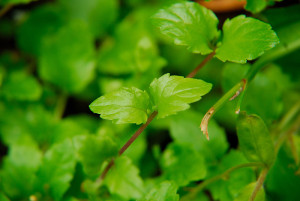
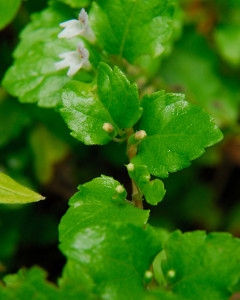
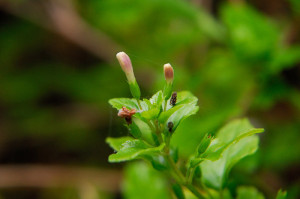
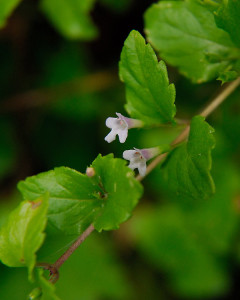
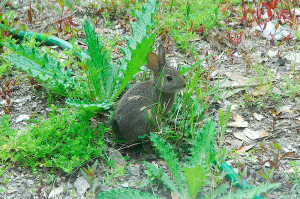

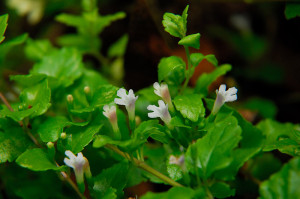








It’s been a good year for yerba buena around our place. It is a bit unpredictable – it’ll be lovely then suddenly it all shrivels up and dies – I don’t really know why. Too much sun? Not enough moisture?
I didn’t know it had been reclassified!
I’ll have to try some tea this weekend myself! – also I haven’t tried propagating it, but seems like a good idea.
I haven’t noticed that ours dies back at all. That area of the slope always seems green, but I haven’t paid close attention to this plant until now. I’ll have to keep an eye on it. I did read that Yerba Buena can survive on as little as 15 inches of annual rainfall, but does great in areas of high rainfall (70 inches a year). I’m under the impression that it can’t be overwatered, but perhaps it may not look its best in a dry year, like the our first two summers here. Too much sun it seems though can be a problem. Ours gets no sun after about 1PM in mid-summer. Still, if it’s easy to propagate, I do think it’s worth experimenting with planting it around here, as the bunnies at least don’t seem to like it 😉
My new favorite plant name — it’s fun to say! Yerba Buena. 🙂
I agree, it does roll off the tongue better than Clinopodium 😛
It’s nice to have an evergreen ground cover, especially when it’s native and throughout areas of your property. It looks like you could even try transplanting some to a pot and treating it like a vine and it reminds me of Ajuga or mint, nice and full.
We don’t have any of that family here, probably because of the drier climate??, but there is an evergreen ground cover that I like and encourage, Chamaebatia foliolosa or bear clover. I groom it by keeping weeds out (of the colonies in the main garden area) and giving the new sprouts the extra summer water they like.
I looked up your Chamaebatia foliolosa, I’d never heard of it before. It almost vaguely reminds me of Chamomile. It’s beautiful though, and its flowers look rather more conspicuous than the ones on Yerba Buena. It’s fun to compare some of the different plant we have here versus the in foothills.
One of the few that pests don’t like! Very informative post…I wonder how flavorful the tea is…
I’m not sure, but if I’m brave enough to try the tea this weekend, I’ll let you know! 😉
Cute picture of the brush rabbit! It reminds me of the bunnies we have in our front garden. The herb buena is quite attractive, and I like its little flowers. I wonder if the tea would taste like the mint tea we make here, which is delicious. I would be interested in seeing the recipe.